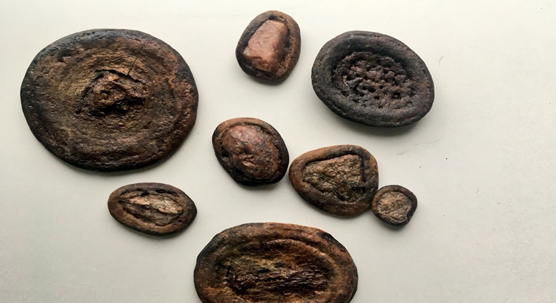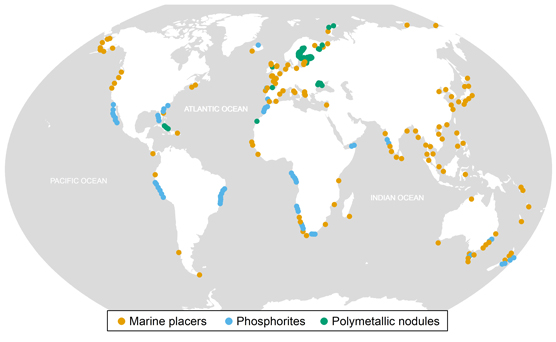
Ferromanganese concretions in the Baltic Sea. © Image: Laura Kaikkonen.
According to a study, mining in shallow marine areas conflicts with international conservation and sustainability goals, bringing with it great environmental risks.
Seabed mining has been proposed as a sustainable option with environmental impact and costs smaller than those of traditional mining. However, according to a study completed at the University of Helsinki, mining in shallow marine areas, for instance in the Baltic Sea, conflicts with international conservation and sustainability goals and brings with it great environmental risks. The lead author of the study is Postdoctoral Researcher Laura Kaikkonen from the Faculty of Biological and Environmental Sciences, University of Helsinki. The second author of the study is Elina Virtanen, Senior Research Scientist at the Finnish Environment Institute (SYKE) and Postdoctoral Researcher at the University of Helsinki’s Finnish Museum of Natural History.
Growing demand for battery metals increases interest in seabed minerals
The metal concentration of marine minerals is often high. The growing demand for nickel, cobalt, and other battery metals has increased interest in minerals found in the seabed. The interest in mining shallow marine areas is growing also in the Baltic Sea region. A Swedish mining company has submitted an application to mine ferromanganese concretions in the Gulf of Bothnia. Mining metallic ore is an industrial field new to the Baltic Sea. Previously tin and diamonds, for example, have been mined in the territorial waters of other countries.
The potential for utilising deep-sea minerals has long been recognised. Their commercialisation has been limited by concerns about the effects of mining on sensitive deep-sea ecosystems. Elina Virtanen reminds that abyssal species are still poorly known and new species previously unknown to science are constantly encountered.
Mining in deep sea areas is also considerably expensive, which is why the mining of minerals from shallow marine areas has been proposed as a more suitable solution to the increasing demand. There are no technical hindrances to extracting minerals from shallow marine areas, as it could be done with suction dredging.
National legislation is needed to regulate mining in marine areas
Minerals and precious metals are found in all marine areas around the globe. There is also an abundance of minerals in Finnish marine areas in the form of ferromanganese concretions, which Kaikkonen and Virtanen described in their previous study, conducted in 2019.
The minerals found in shallow marine areas are not yet widely utilized. There is no national legislation for such regulation, which, in turn, is why the mining industry is turning its gaze to the sea.

Known mineral deposits in shallow marine areas, the commercial utilisation of which is estimated to be possible with current methods. © Elina Virtanen
Risks in mining shallow marine areas yet unknown
The environmental impact of mining in shallow marine areas is not yet known. According to Laura Kaikkonen, the environmental effects are probably similar to those of operations like dredging. It can take decades for the ecosystems to recover. In addition, the ecosystems of shallow marine areas are in a weakened state to begin with, as human activity is concentrated in coastal areas.
Mineral mining in marine areas alters habitats and species communities and causes local biodiversity loss. The indirect effects of mining, such as the spread of swirling seabed material and harmful substances released from the seafloor and the clouding of water, contribute to impair the state of the marine environment.
Elina Virtanen says that the possible environmental effects conflict with the latest conservation and sustainability goals.
The precautionary principle should be applied to mining in shallow marine areas, and operations should not be permitted until their risks have been mapped. According to the researchers, discontinuing mining operations in shallow marine areas can be difficult if they are initiated before the relevant legislation is drafted and enacted.
Inquiries:
- Postdoctoral Researcher Laura Kaikkonen, Baltic Marine Environment Protection Commission HELCOM and University of Helsinki, tel. +358 40 184 1370, e-mail: laura.m.kaikkonen@helsinki.fi
- Postdoctoral Researcher, Senior Research Scientist Elina Virtanen, Finnish Museum of Natural History Luomus and Finnish Environment Institute (SYKE), tel. 050 3853 290, e-mail: elina.a.virtanen@syke.fi
Further reading:
- Link to the article: Kaikkonen, L. & Virtanen, E.. Shallow-water mining undermines global sustainability goals. Trends in Ecology and Evolution.
- Link to the article (2019) about the ferromanganese concretionsin Finnish marine areas: Kaikkonen, L., Virtanen, E., Kostamo, K., Lappalainen J. ja Kotilainen A.: Extensive Coverage of Marine Mineral Concretions Revealed in Shallow Shelf Sea Areas, Front. Mar. Sci., 04 September 2019 Sec. Coastal Ocean Processes
-
Link to the press release published by the Helsinki University (14.9.2022)